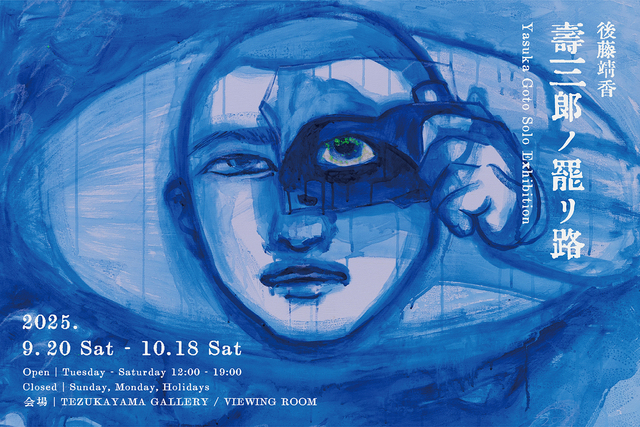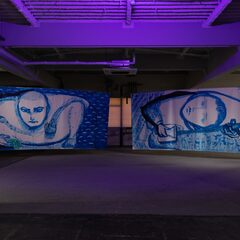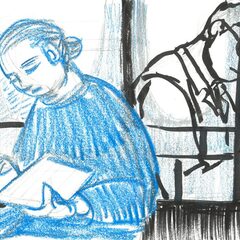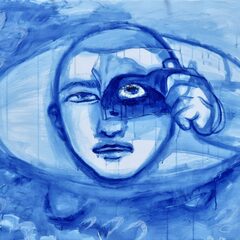
Viewing Room
The Path of Jusaburo
後藤靖香
2025.9.20 Sat - 2025.10.18 Sat
TEZUKAYAMA GALLERY–MAIN GALLERY is pleased to present Yasuka Goto: The Path of Jusaburo from September 20.
Yasuka Goto is known for her practice of excavating buried personal histories—beginning with the wartime experiences of her grandfather and great-uncles, as well as memories inscribed in particular places—and rendering them on large-scale canvases with sweeping, expressive brushwork and dramatic, narrative intensity. Her works are characterized by powerful strokes and an overwhelming presence that leaves a lasting impression on the viewer’s memory.
In recent years, Goto has broadened her practice by exploring Bunraku, the traditional Japanese puppet theater. In 2023, she created the stage designs for Nakanoshima Bunraku 2023—Bunraku × Kodan × Contemporary Art Projection Mapping, producing original drawings in shades of blue as materials for projection mapping, as well as a monumental drawing that adorned the stage curtain. During her research, she discovered that during the war years, Bunraku productions staged works such as Nikudan San-yūshi (“The Three Human Bomb Heroes”) and Kyūgunshin (“The Nine War Gods”), serving as propaganda that glorified war and bolstered the national cause. For Goto, who has long engaged with memories of war through her work, this was an unexpected point of connection. It culminated in the creation of Doudou-meguri (whichi means Endless Loop), which symbolically depicts Sadamu Kamita, one of the “Nine War Gods” who perished in the attack on Pearl Harbor and was presented at ART OSAKA 2024 in the Expanded Section.
This solo exhibition is her first time at TEZUKAYAMA GALLERY in about five years, it takes as its starting point her relative Jusaburo Goto, who lost his life at the epicenter of the atomic bombing of Hiroshima. While Goto has previously depicted the wartime experiences of her grandfather, great-uncles, and the memories of those who survived, this is the first time she confronts the subject of “the atomic bomb and Hiroshima” through a personal connection. Significantly, the exhibition coincides with the 80th anniversary of the end of World War II. As the voices of direct war survivors fade, Goto asks how we might imagine, give form to, and carry forward the unutterable memories of war. Through the story of Jusaburo’s life, this exhibition invites viewers to reflect quietly on that question.
Artist Statement
I have a relative named Jusaburo Goto who died at the hypocenter of the atomic bombing.
In general, the Hiroshima hypocenter is recognized as the Atomic Bomb Dome. However, the actual hypocenter was the Shima Hospital, and Jusaburo was working at the Hiroshima Post Office directly across from that hospital.
He should have already reached retirement age, but under wartime conditions, he probably continued working as one of the few remaining male employees.
On August 6, 1945, he was on duty at the post office. Together with other staff members and mobilized students, he was killed by the direct impact of the bomb.
His body could not be identified. His home, located 1.3 kilometers from the hypocenter, was also destroyed, and all belongings and photographs were burned and nothing was left.
If anything remained, it was only the main Goto family house, where he should have spent his retirement years. Yet that house was later demolished to make way for a highway, and its materials were reused in the branch family house where I live today.
“I may have taken away the place where Jusaburo was supposed to return.”
Such a thought crosses my mind.
Until now, I have painted war images inspired by my grandfather, who was a kamikaze soldier, and other wartime episodes.
In postwar Japan, the stories of perpetrators have, in a sense, become taboo.
War paintings are often condemned as glorifying or romanticizing war.
And yet, I deliberately chose to paint them.
While the narratives of victims have been told in depth since the war, I feel that there are still untold stories on the side of the perpetrators.
My paintings are precisely such “untellable stories of perpetrators.”
But now I wonder if my persistence came from my own anxiety—perhaps I myself might also be a perpetrator.
In researching Jusaburo, I came to realize that the house I now live in was originally his. That realization made my anxiety all the more real.
So surely, I must also depict my own story.
The word Magariji(in the title of this work refers to “the road home,” or alternatively, “the path of the dead, the road to the afterlife.”
I live today in the very place where Jusaburo should have returned.
Therefore, this work is both the story of Jusaburo Goto and the story of myself, Yasuka Goto.
Yasuka Goto



